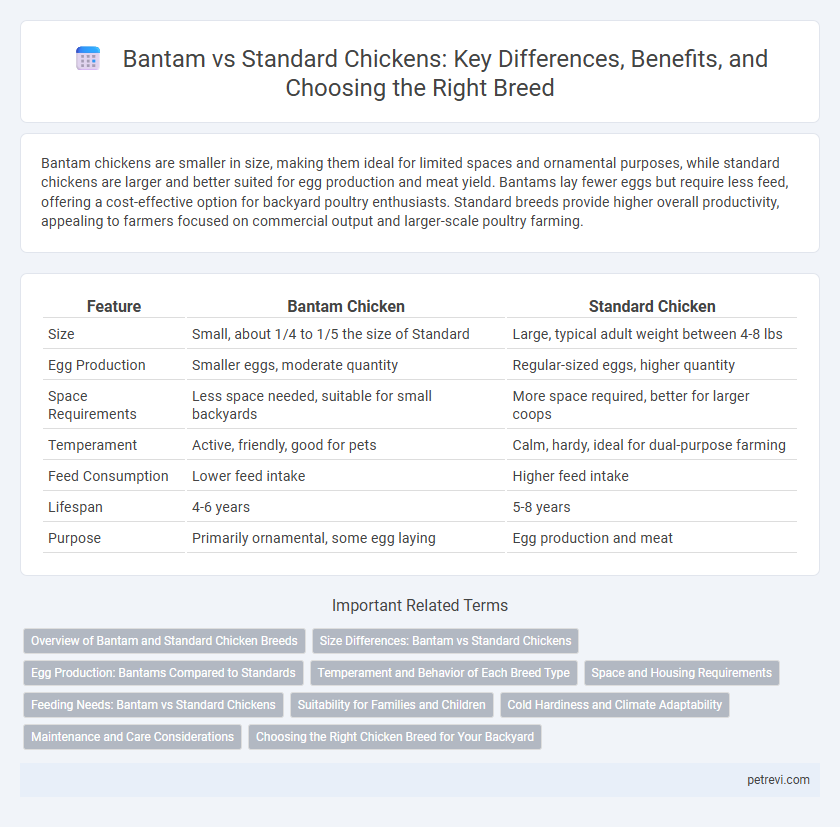Bantam chickens are smaller in size, making them ideal for limited spaces and ornamental purposes, while standard chickens are larger and better suited for egg production and meat yield. Bantams lay fewer eggs but require less feed, offering a cost-effective option for backyard poultry enthusiasts. Standard breeds provide higher overall productivity, appealing to farmers focused on commercial output and larger-scale poultry farming.
Table of Comparison
| Feature | Bantam Chicken | Standard Chicken |
|---|---|---|
| Size | Small, about 1/4 to 1/5 the size of Standard | Large, typical adult weight between 4-8 lbs |
| Egg Production | Smaller eggs, moderate quantity | Regular-sized eggs, higher quantity |
| Space Requirements | Less space needed, suitable for small backyards | More space required, better for larger coops |
| Temperament | Active, friendly, good for pets | Calm, hardy, ideal for dual-purpose farming |
| Feed Consumption | Lower feed intake | Higher feed intake |
| Lifespan | 4-6 years | 5-8 years |
| Purpose | Primarily ornamental, some egg laying | Egg production and meat |
Overview of Bantam and Standard Chicken Breeds
Bantam chicken breeds are miniature versions of standard breeds, typically weighing less than 2.5 pounds, making them ideal for small coops and ornamental purposes. Standard chicken breeds generally weigh between 5 to 10 pounds and are favored for meat production and egg-laying capabilities. Bantams require less space and feed, while standards are preferred for higher yield in farm settings.
Size Differences: Bantam vs Standard Chickens
Bantam chickens are significantly smaller than standard chickens, typically weighing between 1 to 2.5 pounds, whereas standard breeds range from 5 to 10 pounds or more depending on the breed. The compact size of bantams makes them ideal for limited space environments and ornamental purposes, while standard chickens are preferred for meat production and larger egg yields. This size disparity affects their housing requirements, feed consumption, and overall care.
Egg Production: Bantams Compared to Standards
Bantam chickens typically produce smaller eggs compared to standard breeds, with bantam hens averaging 100-150 eggs annually while standard hens can lay 250-300 eggs per year. Egg size and quantity are significant factors in choosing between bantam and standard breeds, as bantams excel in space efficiency but yield fewer and smaller eggs. For backyard poultry keepers focused on maximizing egg production, standard breeds often provide a more productive option than bantams.
Temperament and Behavior of Each Breed Type
Bantam chickens are known for their lively and inquisitive temperament, often displaying more active and social behavior compared to standard breeds. Standard chickens tend to be calmer and more docile, making them easier to handle and better suited for beginner poultry keepers. Both breed types exhibit friendly interactions with humans, but bantams are generally more energetic and vocal.
Space and Housing Requirements
Bantam chickens require significantly less space than standard breeds, making them ideal for small backyards or urban settings. They typically need about 1 to 1.5 square feet per bird inside the coop and 4 to 5 square feet in the outdoor run. Standard chickens demand more spacious housing with at least 2 to 3 square feet per bird inside the coop and 8 to 10 square feet in the outdoor run to maintain optimal health and comfort.
Feeding Needs: Bantam vs Standard Chickens
Bantam chickens require less feed due to their smaller size, consuming approximately 25-30% less than standard breeds, making them more cost-effective for small-scale or hobbyist poultry keepers. Standard chickens demand a higher quantity of feed, roughly 100-120 grams per day per bird, to sustain their larger body mass and egg production. Optimizing feed formulations for each breed can improve growth efficiency and overall health, with bantams benefiting from nutrient-dense feeds tailored to their compact size.
Suitability for Families and Children
Bantam chickens are smaller and gentler, making them ideal for families with children as they are easier to handle and require less space. Standard breeds, though larger and more robust, may be too active or intimidating for young kids but provide higher egg production and meat yield. For a family-friendly experience, bantams offer calmer temperaments and safer interactions, enhancing educational opportunities while keeping maintenance manageable.
Cold Hardiness and Climate Adaptability
Bantam chicken breeds generally exhibit better cold hardiness due to their smaller body size and higher metabolic rates, which enable quicker heat generation in chilly climates. Standard chicken breeds often adapt well to moderate climates but may require additional shelter or care during harsh winters to maintain optimal health. Selecting the right breed for cold environments depends on balancing size, feather density, and overall climate adaptability to ensure survival and productivity.
Maintenance and Care Considerations
Bantam chickens require less space and consume less feed compared to Standard breeds, making their maintenance more cost-effective and suitable for small-scale or urban settings. Standard chickens demand larger coops and more substantial feed portions, necessitating greater investment in housing and nutrition to support their size and productivity. Both breeds benefit from routine health checks and clean living environments, but Standard breeds may need more frequent care to manage their higher metabolic and space needs.
Choosing the Right Chicken Breed for Your Backyard
Bantam chickens are smaller in size, making them ideal for limited backyard space and easier to manage for beginner chicken keepers. Standard breeds typically provide larger eggs and higher meat yield, suitable for those prioritizing production over space constraints. Selecting between bantam and standard breeds depends on your goals, available space, and desired chicken purposes like egg-laying, aesthetics, or meat production.
Bantam vs Standard for Chicken Breed Infographic

 petrevi.com
petrevi.com